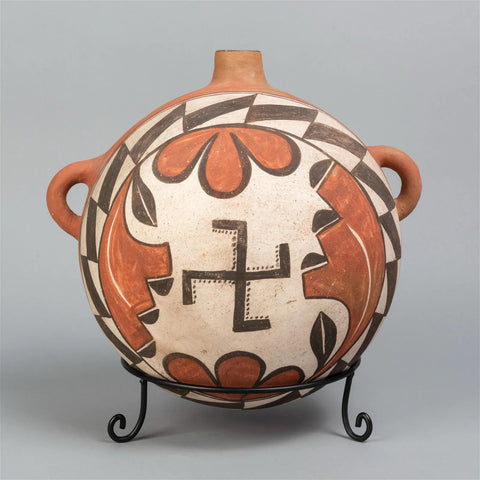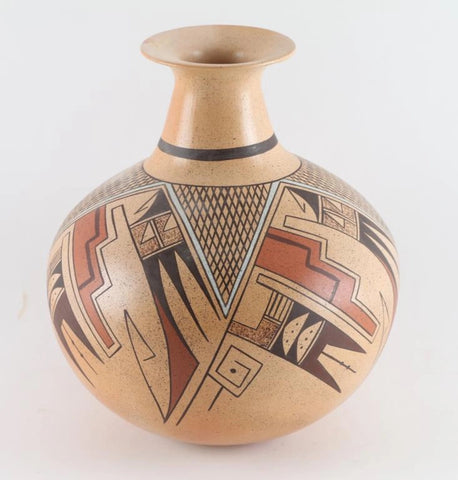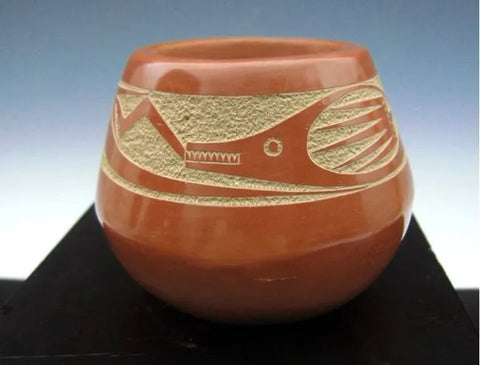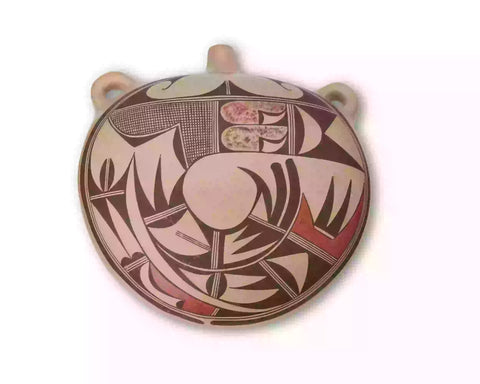
Native American, Burel Naha (b. 1944) Exquisite Pottery Seed Jar, #1121
$ 1,537.00
Native American,
Burel Naha (b. 1944) Exquisite Pottery Seed Jar, #1121
Discriiption: #1121 Native American, Burel Naha (b. 1944) Exquisite Pottery Seed Jar, of spherical form and painted with two large, hairy legged spiders; a spider web is ghosted in the background; hallmarked on base;
Dimensions: height 4 in. x diameter 4.25 in.
Condition: Excellent.
Burel Naha is the son of Helen Naha (Feather Woman) and grandson of Paqua Naha (Frog Woman) and brother of Rainy Naha and Sylvia Naha. Burel and his sisters continued the tradition of their famous mother in producing pottery of the finest quality and with superb design creations. He signs his pottery with a Feather and Longhair Katsina Hallmark.
Burel specializes in traditional Hopi pottery but has created his own unique style. He enjoys painting spiders with intricate web designs all around his pottery. The earlier designs that he used were of the style of his mother's.
Burel received his BA at Brigham Young University. He was a teacher for many years and now has dedicated his life to the traditional ways of his Hopi ancestors. Burel credits his success to his mother for teaching him the traditional ways of their ancestors.
He has received awards from the New Mexico State Fair and the Gallup Inter-tribal Indian Ceremonial.
-Biography from Artists in Clay: The Winona Sate University Collection of Southwest Native American Pottery (Source: Adobe Gallery)
“Pueblo pottery is made using a coiled technique that came into northern Arizona and New Mexico from the south, some 1500 years ago. In the four-corners region of the US, nineteen pueblos and villages have historically produced pottery. Although each of these pueblos use similar traditional methods of coiling, shaping, finishing and firing, the pottery from each is distinctive. Various clays gathered from each pueblo’s local sources produce pottery colors that range from buff to earthy yellows, oranges, and reds, as well as black. Fired pots are sometimes left plain and other times decorated—most frequently with paint and occasionally with applique. Painted designs vary from pueblo to pueblo, yet share an ancient iconography based on abstract representations of clouds, rain, feathers, birds, plants, animals and other natural world features.
Tempering materials and paints, also from natural sources, contribute further to the distinctiveness of each pueblo’s pottery. Some paints are derived from plants, others from minerals. Before firing, potters in some pueblos apply a light colored slip to their pottery, which creates a bright background for painted designs or simply a lighter color plain ware vessel. Designs are painted on before firing, traditionally with a brush fashioned from yucca fiber.
Different combinations of paint color, clay color, and slips are characteristic of different pueblos. Among them are black on cream, black on buff, black on red, dark brown and dark red on white (as found in Zuni pottery), matte red on red, and poly chrome—a number of natural colors on one vessel (most typically associated with Hopi). Pueblo potters also produce un- decorated polished black ware, black on black ware, and carved red and carved black wares.
Making pueblo pottery is a time-consuming effort that includes gathering and preparing the clay, building and shaping the coiled pot, gathering plants to make the colored dyes, constructing yucca brushes, and, often, making a clay slip. While some Pueblo artists fire in kilns, most still fire in the traditional way in an outside fire pit, covering their vessels with large potsherds and dried sheep dung. Pottery is left to bake for many hours, producing a high-fired result.
Today, Pueblo potters continue to honor this centuries-old tradition of hand-coiled pottery production, yet value the need for contemporary artistic expression as well. They continue to improve their style, methods and designs, often combining traditional and contemporary techniques to create striking new works of art.” (Source: Museum of Northern Arizona)









